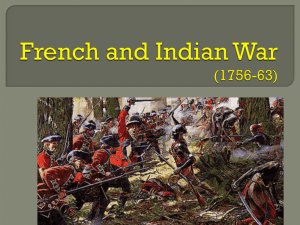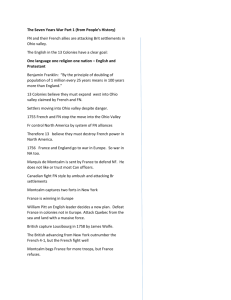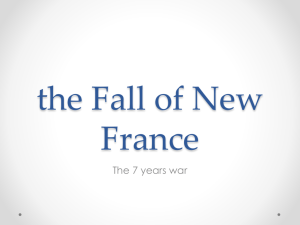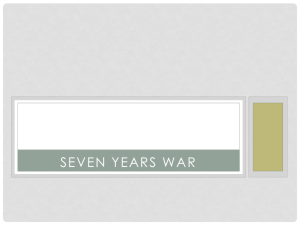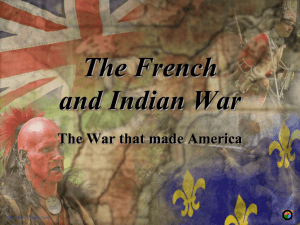Seven Years War Ppt
advertisement
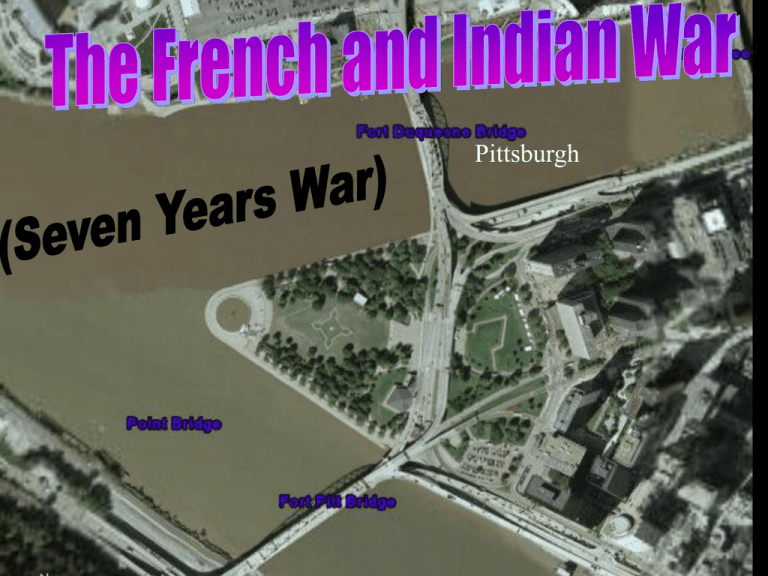
Pittsburgh Participants Involved in Seven Years War Great Britain, Prussia, Portugal, with allies France, Spain, Austria, Russia, Sweden with allies Reasons for Seven Years War Continuation of War of Austrian Succession Abandonment of alliances, formation of new ones. Austria leaves Great Britain, allies w/ France Prussia (army) joins Great Britain (navy) Colonial expansion in N. America by Great Britain and France Austria & Russia fear Prussian emergence European Kingdoms of 1750s Cause of French & Indian War Study the map and describe one cause of the French and Indian War? Causes of French & Indian War From the Diagram, list two causes of the French and Indian War? Population and Economic Push Into the Ohio Valley The Seven Years War is related to these other conflicts… King George’s War (1744-48) Third Silesian War (Austrian Succession) The French and Indian War Remember, rivalries in Europe always spill over into the Colonies. Mission: To rid the Ohio Valley of the French Invaders. Strength: 1400 British Regulars; smaller number of Colonial Militia Braddock “halted to level every mole hill and to erect bridges over every brook by which means we were four days getting twelve miles” (Washington) Braddock’s Dilemma: Tried to fight a European style war in the wilderness of Pennsylvania. Braddock’s force is routed and retreats in disarray. During the battle on July 9th Braddock is mortally wounded. Braddock dies and is buried in the middle of the road he built and the remainder of his army marches over him to hide the grave from the French and their allies. Failed to secure Ft. Duquesne (Pittsburgh). Suffered over 1000 Casualties, including himself. Washington to the rescue again. Britain Declares War on France Alliance with Prussia (Germans). Prussia v France and its Allies in Europe. Britain fought France in the Caribbean, India, and North America. British suffer many losses in the early years of the war: Settlements are attacked; lose forts on Lake Ontario and Lake George. Question: What does it take to fight a war? William Pitt The right person at the right time, and in the right place can make all the difference. Secretary of State Prime Minister Military Logistician Excellent Judge of Military Commanders Global Thinker September 13, 1759 (250yrs ago) Quebec THE BATTLE OF THE PLAINS OF ABRAHAM Background Seven Year’s War – both Europe and North America (1756-1763) In Canada, early French success, more manpower and forts Later (1758-1759), British success – more money, soldiers are allotted, power of Royal Navy By 1759, New France faced odds of nearly 3 to 1 in terms of ships, 4 to 1 in terms of regular soldiers, and 10 to 1 in money Main Players James Wolfe – commander of British invasion fleet sent to take Quebec Invasion force = 13,500 men, 4000 in strike force (mostly regular soldiers) Main Players France – Marquis de Montcalm Approximately 4500 men (mostly militiamen) Problems with French Defense West side of city walls facing the Plains of Abraham had no gun reinforcements Left undefended the south bank of the river opposite the city and shortly after their arrival, the British established batteries there and were able to launch attacks Under cover of fire, Royal Navy could transport its ships up the river without counterattack Summer 1759 All summer British took garrisons all around modern day provinces of Quebec and Ontario Devastated the parishes around Quebec city. On the south shore of the St. Lawrence River, the British destroyed 1000 buildings as well as the Canadiens’ harvest Battle Preparations Wolfe wanted to force Montcalm into an open, European-style battle, but was running out of time – the Navy had to go back to Britain for the winter However, he found a small cove called Anse au Foulon from which a narrow goat path led up the steps of the cliff to Quebec garrison French believed no force could climb the narrow path so left it undefended French Mistakes French failed to establish a password for a French convoy expected to bring supplies on the night of September 12 The British attack was a complete surprise – French sentries on the shore thought that the boats gliding past them were part of the French convoy (was actually cancelled) and Wolfe had those soldiers who could speak French answer the French sentries in their own language Ready for Attack In total, 3 landing ships reached the shore The advance force of Scottish Highlanders walked up the steep path, two by two, and, without detection, gained the summit of the cliffs and overpowered the French post there Wolfe’s Luck Wolfe’s risks paid off The sentries did not recognize the British in time because the convoy had been expected His difficult landing was successful and without problems The Plains of Abraham Wolfe deployed 4500 troops on the Plains of Abraham, the grassy field near the unarmed western walls of the fort Montcalm makes a fatal error- Instead of waiting for Colonel de Bougainville to arrive with 3000 regulars stationed at Cap Rouge, 15 km upstream, he impulsively attacks The Battle Unfolds British strategies – Three quarters of men deployed in one line in a concentration of firepower When the French army was only 40m away, the command to fire was given and the French were devastated, their lines in chaos One volley later, they retreated up the St. Lawrence River Battle lasted less than 30 minutes The two forces were numerically equal, however, the British force was composed of regulars and the French, poorly trained militiamen British Casualties Approximate -ly 650 men Wolfe was shot and killed on the battlefield French Casualties Approximately 650 men Montcalm was also wounded in battle and died from his wounds the next morning By September 18, the fort at Quebec, short of provisions and soldiers and weakly fortified on its west side, was surrendered Repercussions The battle was a serious blow to the French, but all was not lost on September 13 France still controlled the rest of the St. Lawrence valley and its army was still in tact Contrary to popular belief, the Battle of the Plains of Abraham did not determine New France’s fate. It was a naval battle fought at Quiberon Bay off the coast of France during which the British navy’s destruction of the French fleet later prevented France from sending a rescue force to save Canada, that sealed its fate Repercussions cont’d During an attempt to recapture Quebec, the French army ran short of ammunitions and supplies and no ship was available to come from France to its aid Almost one year later, September 18, 1760 – the French surrendered all of New France and the British took the final French stronghold at Montreal Amherst gained fame during the Seven Years' War, particularly in the North American campaign known in the United States as the French and Indian War. After he served in Europe in 1757, Amherst led the British attack on Louisbourg in 1758, and as commander-in-chief of the British army in North America, led the successful British conquest of New France. In 1759, while James Wolfe besieged and eventually captured Quebec with one army, Amherst led another army against French troops on Lake Champlain, where he captured Fort Ticonderoga against little resistance. On September 8, 1760, he led an army down the Saint Lawrence River from Lake Ontario, and captured Montreal, ending French rule in North America. He infuriated the French commanders by refusing them the "honours of war" (the ceremonial right of a defeated garrison to retain their flags); the Knight of Lévis burned the colors rather than surrendering them. Amherst held the position of military governor of Canada from 1760 to 1763 Use of smallpox-infected blankets The hostility between the British and Native Americans after the French and Indian War led to one of the first documented attempts at biological warfare in North American history. In response to the 1763 uprising known as Pontiac's Rebellion, Colonel Henry Bouquet wrote to Amherst, his commanding officer, with the suggestion that the British distribute smallpox-infected blankets to Indians. Amherst approved the plan and expressed his willingness to adopt any "other method that can serve to Extirpate this Execrable Race." In fact, the commander at Fort Pitt had already attempted this very tactic in June 1763. It is the only recorded case of British soldiers giving smallpox-contaminated blankets to Native Americans Peace: Treaty of Paris 1763 England Receives Canada French Lands East of the Mississippi Florida From Spain Spain Receives Lands West of Mississippi and New Orleans France allowed to keep Sugar Producing Islands in the Caribbean and fishing in the Grand Banks islands of St Pierre et Miquelon. Peace Treaties Lead to War Question: Who is especially unhappy about the French loss? The Native Americans. British Trappers and Settlers refuse to pay Native Americans for the use of the land in the Ohio Valley Chief Pontiac of the Ottawa Native people puts together a Native American Alliance and strikes back at the British. Pontiac fails to capture key terrain. Pontiac’s War ends in 1765. Cause of the American Revolution Pitt decides to fund the war through the British Treasury and through loans. This relieves the American colonists from fronting the bill for the war. However, after the war is over, Britain must settle its debts and pay for a standing army in America. In order to do this they decide to have the colonists bear some of the burden for their own defense. Cause of the American Revolution The Proclamation of 1763 Proclaimed that land west of the Appalachian Mountains temporarily off limits to settlements. British Halt Westward Expansion to minimize costs in maintaining a military force to secure the Frontier. Colonists upset. Especially those who had bought shares in companies or bought land in the newly captured territories. However, this does create a fragile peace between the British and the Native Americans. 11 years later… The Quebec Act of 1774 was an Act of the Parliament of Great Britain setting procedures of governance in the Province of Quebec. The principal components of the act were: The province's territory was expanded to take over part of the Indian Reserve, including much of what is now southern Ontario, plus Illinois, Indiana, Michigan, Ohio, Wisconsin and parts of Minnesota(this angered the Yankees!) The oath of allegiance was replaced with one that no longer made reference to the Protestant faith. It guaranteed free practice of the Catholic faith. It restored the use of the French civil law for private matters while maintaining the use of the English common law for public administration, including criminal prosecution. The Act had wide-ranging effects, in Quebec itself, as well as in the Thirteen Colonies. In Quebec, English-speaking migrants from Britain and the southern colonies objected to a variety of its provisions, which they saw as a removal of certain political freedoms. French-speaking Canadiens varied in their reaction; the land-owning seigneurs and clergy were generally happy with its provisions. In the Thirteen Colonies, the Act, which had been passed in the same session of Parliament as a number of other acts designed as punishment for the Boston Tea Party and other protests, was joined to those acts as one of the Intolerable Acts. The provisions of the Quebec Act were seen as a new model for British colonial administration, which would strip the colonies of their elected assemblies, and promote the Roman Catholic faith in preference to widely-held Protestant beliefs. It also limited opportunities for colonies to expand on their western frontiers, by granting most of the Ohio Country to the province of Quebec. Thus, it can be said that a piece of legislation intended to govern the French in Quebec ended up causing the war that gave birth to the United States of America! PLUS…THE FRENCH GENERAL LAFAYETTE HELPED AMERICA FIGHT ENGLAND FROM 177883…AND WIN!!! “MERCI BEAUCOUP LES QUEBECOIS ET LES FRANCAIS POUR LE VICTOIRE AMERICAINE DANS LA GUERRE REVOLUTIONAIRE!”


